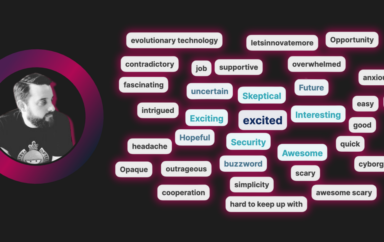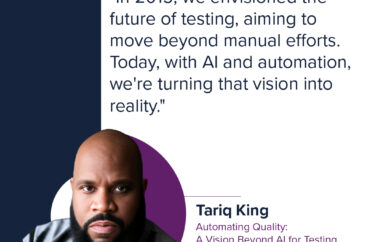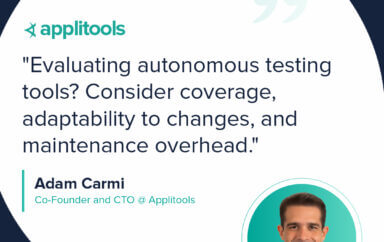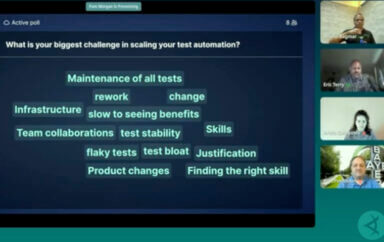As 2017 comes to a close, it’s been a great time to reflect back on the year and look ahead to what 2018 might have in store, especially in regards to software testing and automation. To dig into this a little deeper, we recently hosted a webinar featuring some of the software testing industry’s most prominent experts and thought leaders discussing the hottest tools, technologies and trends to look out for in 2018.

Our guests included host Joe Colantonio, founder of Automation Guild Conference; and distinguished speakers:
Angie Jones, prolific speaker and senior software engineer in test at Twitter;
Richard Bradshaw, software tester, speaker and trainer at Friendly Testing; and, our very own
Gil Tayar, senior architect and evangelist.
During the webinar, they discussed the top test automation strategies for 2018, how AI will affect automation, the new tools and tech you should explore, and much more. Continue reading for some of their top insights that will help prepare you for the year to come:
Colantonio reflects on some of the trends he has seen in 2017: “As I speak to a lot of companies I see a lot of digital transformations going on. I see a lot of studies saying QA and testing investment is going to be really heavy the next five years. Also, what I’ve been seeing is a lot of companies are shifting to the left, so they’re investing more and more in how they can automate their process to make it quicker for the software development.”
Jones says that companies will be thinking about how to use it more strategically in 2018: “I think in 2018 we’ll see people taking a step back and looking at what is it that they actually want to gain from automation, and how to best do that. I’m also seeing a lot of teams now wanting to embrace DevOps. As we are moving into that space we see testing, automation, development, and everything is moving a lot faster. There’s definitely a need for automation to not just be running on someone’s local machine or running along somewhere on a server, but to actually be gating check-ins and giving teams confidence.
Bradshaw offers some advice on how to speed up your software delivery in 2018: “I think one of the opportunities to take advantage of in 2018 is to step back a bit, have a reflection of the skills that you’ve developed. How good is your programming now? How many tools are in your tool box? Start to look where we can apply them throughout the software development lifecycle. The things that I’m looking at myself is our automated checks and feedback loops. So, having a look at all the checks you have and reducing some of them. Do you need them all? Are they valuable? And that will help you speed up.”
Tayar hopes that more companies will embrace the shift-left movement and put more of the testing responsibility on developers: “From my perspective, the shift left movement, where the boring parts of testing, the regression testing, is moving towards development and towards developers. I think this is a trend that I’m seeing more and more 2017 and
in mostly advanced, high performing companies. Hopefully in 2018 more companies will be able to do more and more testing on the developer side. That will enable testers to find the more interesting problems to do. Not just regression test, but more interesting things with their testing time.
Colantonio on the importance of testing at the API level: “As more folks move towards continuous integration and continuous delivery, I think we need integration tests and to give faster feedback that isn’t just about the UI. I think API testing is really a critical piece of that. If the business layer is not in the UI, then we should test that at the API level. So that’s a great opportunity. I’m not sure why more people aren’t getting into it.”
Consider developing skills in web services automation in 2018, advises Jones: “I can probably count on one hand the people who are experts in web services automation, and that’s a problem because there’s a big demand for that right now. So I think this is an opportunity where if you are looking to get into automation, or if you’re already in automation and you’ve been focused very heavily on UI automation, there’s an opportunity here for people to advance their skills and look into web services automation.”
For AI tools to provide value, testers first need to understand the purpose of their test, explains Bradshaw: “The use of AI that I’m seeing advertised at the moment by lots of companies is to help them. They’re using AI to help the tool design automated checks. That sends alarm bells off in me because I don’t think many testers out there even know what they’re doing. Not that they don’t know when they’re testing, and that they don’t know their own thought process. They don’t actually understand what they’re going through. They don’t know why they find bugs. They don’t know why they do the tests that they do, they just do them.”
Simple advice from Tayar is to embrace agility: “Agility is the movement towards faster release cycles, and that fuels the need for developers to create their own tests. Once developers create their own tests that leaves testers to do the really, really important stuff. To test from a thinking perspective, and not so much doing the work that developers should’ve done by themselves. So if there’s one thing to remember, it’s to embrace agility. Use that to do better testing, better automation, better thinking about what you’re testing so that your company will get an advantage from that.”
Don’t just put blind faith into your AI tools, warns Jones: “In 2018, I don’t think we’re going to see a bunch of AI being used to assist us, but I think we could use 2018 to take the opportunity to understand, what is AI? And reveal how it will be used to help us, and if it can really even help us. A lot of times we look at AI as, ‘Oh, it’s this perfect thing.’ And I can tell you that it’s not perfect. I’m working on some applications here, and even before I got here to Twitter, products that are using machine learning, which is a subset of AI. It can’t be a black box that I think works magically. I have to understand what it’s supposed to do and how to test that.”
Bradshaw: “I would like to see some tools come into the market that are specifically designed to support me and my testing. They’re looking at what I’m doing on the screen and they might fire heuristics at me. They might say, ‘Richard, you seem to have done some kind of testing like this many years, or a few months ago, a few releases ago. And then you used this heuristic and found a bug, so why don’t you try that heuristic?’ Or have it as a little bot that’s just there helping me do my job, like take a screenshot for me and it automatically put it on my tickets. But in terms of the AI bit, just having it prompt me to help me think about what I would test based on what I’ve done in the past, I think that is a better use for AI at the moment.”
Will AI be taking over testers jobs? A resounding “No” says Tayar: “I get a lot of questions about, ‘Do I need to worry about my job?’ And the answer is a very, very emphatic, ‘No, you do not.’ We’re very early. We’re in the early, early phases of using AI in testing. And I believe that in 10 years and maybe even more we will be using AI as a tool and not so much as a replacement for testers. A tool in that it will be able to, for example, visually compare stuff so that you will be able to find your bugs in a quicker way, and not check every field that you need to fill, but just holistically check the whole page in one go. It will be able to find lots of changes in lots of pages at one time.”
Bradshaw: “My actionable advice right now would be go back into your office, go through your automated checks that you have now and try and delete five of them. And try and go understand them all, review them, study them, continuously review them, and delete them down to the ones that really matter. Because I can go until you probably all have some that are just providing no value at all, but they are taking a few minutes to run every time you do it. So continuously review those checks.”
Watch the full replay:
To read more about Applitools’ visual UI testing and Application Visual Management (AVM) solutions, check out the resources section on the Applitools website. To get started with Applitools, request a demo or sign up for a free Applitools account.








